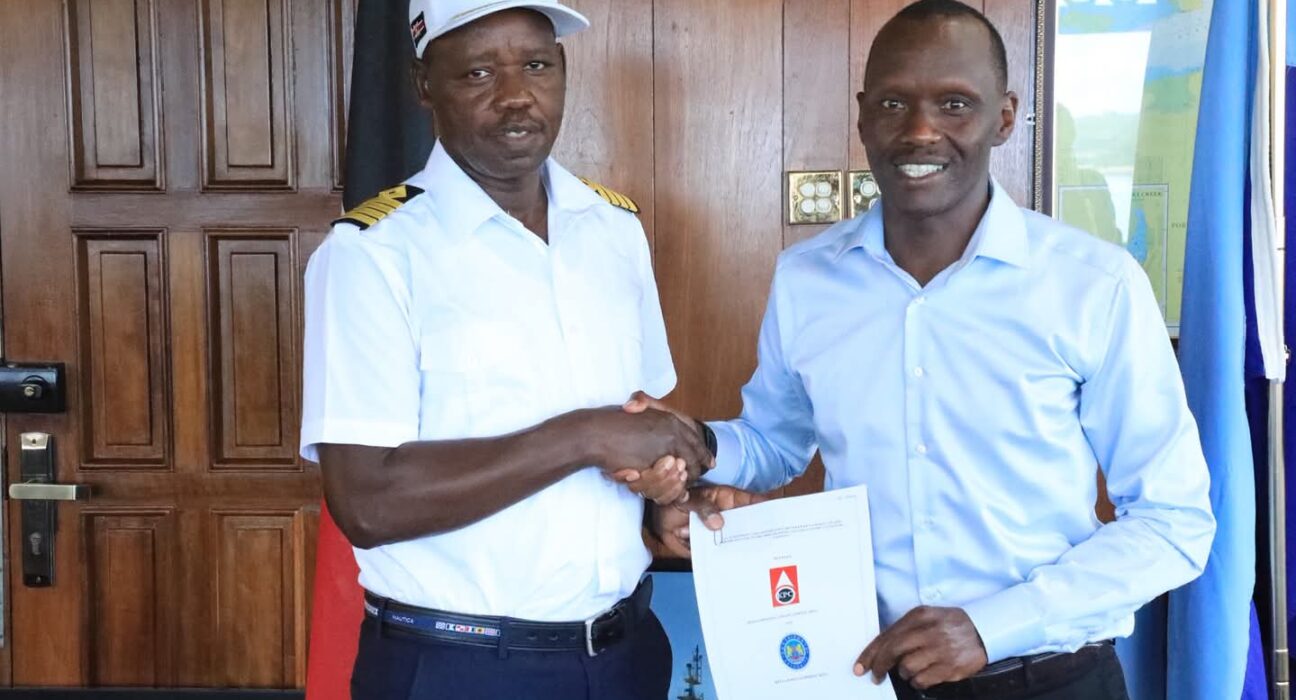The Kenya Ports Authority (KPA) and the Kenya Pipeline Company (KPC) have entered into a strategic cooperation agreement aimed at strengthening operational efficiency, safety, and infrastructure resilience at the Port of Mombasa’s oil terminals.
The partnership marks a significant milestone in inter-agency collaboration between two of Kenya’s most critical state corporations in the energy and logistics sectors. It specifically focuses on rehabilitating the firefighting system at Pump Station No. 14, located at the new Kipevu Oil Terminal (KOT II), one of East Africa’s most modern oil handling facilities.
Signed by KPA Managing Director Captain William Ruto and KPC Managing Director Joe Sang, the agreement underscores the government’s commitment to improving safety and operational standards across the country’s petroleum logistics chain. It also reflects Kenya’s broader drive to optimize state assets through collaborative projects that enhance national infrastructure.
“Today’s signing represents a major step forward in ensuring safety, reliability, and operational excellence at one of our most strategic facilities,” said Capt. Ruto. “This collaboration is not just about infrastructure—it’s about aligning our shared mandate to secure Kenya’s energy supply chain and promote economic efficiency.”
Capt. Ruto added that the partnership is part of the government’s agenda to foster synergy among state agencies to deliver on the country’s long-term development goals under the Bottom-Up Economic Transformation Agenda (BETA).
“This initiative is proof that when our state entities work together, we can achieve far greater outcomes for the economy. A safe and efficient oil terminal means reduced risks, improved trade facilitation, and enhanced investor confidence in our ports,” he said.
KPC Managing Director Joe Sang welcomed the agreement as a continuation of the longstanding cooperation between the two entities, particularly in the handling, storage, and transportation of petroleum products. He emphasized that integrating safety systems and technical expertise would improve response times and reduce downtime in case of emergencies.
“The rehabilitation of the firefighting systems at KOT II is a critical safety enhancement. It ensures that our facilities meet international standards and that Kenya remains a reliable petroleum hub for the region,” Mr Sang noted. “We look forward to leveraging KPC’s engineering and safety expertise to support KPA in this important upgrade.”
Strategic Importance of KOT II
The Kipevu Oil Terminal II (KOT II), commissioned in 2022, is Kenya’s largest and most advanced oil handling facility. Built at a cost of approximately KSh 40 billion, the terminal replaced the old Kipevu Oil Terminal that had been in operation since the 1960s.
The modern terminal can handle four vessels simultaneously and accommodate up to 200,000-deadweight-tonne ships. It is connected to the Kenya Pipeline Company’s inland pipeline system, which transports petroleum products to Nairobi, Kisumu, Eldoret, and neighboring countries such as Uganda, Rwanda, and the Democratic Republic of Congo.
Since its commissioning, KOT II has been instrumental in reducing vessel waiting times, enhancing loading and offloading efficiency, and supporting Kenya’s role as a regional petroleum logistics hub. The latest collaboration between KPA and KPC builds upon these gains by focusing on safety and reliability—two crucial pillars for sustainable operations.
Enhancing National Energy Security
The partnership comes at a time when Kenya is positioning itself as a key player in the region’s energy corridor. The Port of Mombasa handles the majority of petroleum imports for Kenya and transit products for neighboring countries, making efficient and safe operations at KOT II vital for regional supply stability.
By upgrading firefighting and safety systems, the two agencies aim to minimize operational risks and strengthen emergency response capacity. The move is expected to reduce the likelihood of costly disruptions, protect infrastructure investments, and safeguard the environment.
According to Capt. Ruto, the joint approach ensures “a robust and coordinated safety framework” that will improve overall resilience within the port’s oil handling ecosystem.
Industry experts say the cooperation could serve as a model for other state-owned enterprises in the transport and energy sectors, where overlapping mandates often create inefficiencies.
“This partnership is a positive signal that Kenya’s infrastructure agencies are moving toward integrated planning and shared technical standards,” said an industry analyst familiar with port operations. “A unified approach between KPC and KPA can significantly cut duplication of costs and enhance asset utilization.”
Broader Policy Alignment
The collaboration aligns with the government’s agenda of promoting inter-agency cooperation to deliver efficient public services and maximize the use of state resources. Under the Ministry of Energy and Petroleum and the Ministry of Transport, the KPC and KPA have been key implementers of policies aimed at strengthening Kenya’s logistics backbone.
In recent years, the government has encouraged closer coordination between key parastatals to improve delivery timelines for large-scale infrastructure projects. The rehabilitation of the firefighting systems at KOT II is one such initiative where technical and operational expertise is pooled to achieve faster, safer, and more cost-effective outcomes.
The Ministry of Energy has identified operational safety and sustainability as priority areas in the ongoing modernization of Kenya’s fuel logistics network. With the increasing throughput at KOT II and growing regional demand for petroleum products, reliable firefighting infrastructure is seen as essential for mitigating industrial risks and ensuring uninterrupted supply chains.
Looking Ahead
The newly signed cooperation agreement sets the stage for further joint initiatives between KPA and KPC. Both organizations have expressed interest in exploring additional areas of partnership, including digitalization of fuel tracking, environmental management, and emergency preparedness training for port and pipeline staff.
Capt. Ruto said the institutions would also work on aligning operational procedures, maintenance protocols, and risk management standards to international benchmarks.
“Our goal is to ensure that every aspect of the oil terminal’s operation meets world-class safety and efficiency standards,” he said. “This agreement is the foundation upon which we will continue to build sustainable infrastructure for Kenya’s energy future.”
Mr Sang echoed the sentiment, noting that enhanced safety systems are not only a regulatory requirement but also a business imperative.
“A reliable oil terminal benefits the entire economy—from importers to consumers. We are proud to play our part in strengthening Kenya’s competitiveness as a regional hub,” he concluded.
As Kenya continues to expand its infrastructure to meet growing energy and trade demands, the KPA–KPC collaboration at Kipevu Oil Terminal II represents a concrete step toward ensuring that progress is matched with safety, efficiency, and resilience.





